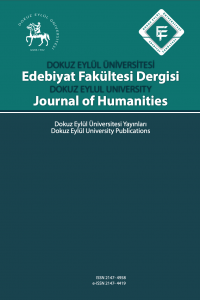Öz
Her metin kendi içerisinde derin anlamlar barındırmaktadır. Bu bağlamda da okuyucu, bu derin anlamları kendi bakış açısıyla yeniden anlamlandırmaya çalışmaktadır. Bu noktada, okuyucunun metni hem yorumlaması hem de çözümlemesinde yol gösterici yöntemlerden biri göstergebilimdir. Gösteren ve gösterilen ilişkisi üzerinde kurulu olan göstergebilim, metnin bilinçli bir biçimde okunmasını ve metnin anlamsal yapısını çözümlemede yol göstermektedir. Çalışmanın inceleme nesnesini oluşturan Cüce adlı yapıt göstergebilim kuramının metin çözümleme araçları çerçevesinde ele alınıp metnin anlam evrenine girilmiştir. Bu noktada metin çözümleme araçlarıyla metnin en derin ve en küçük anlamsal yapısına ulaşma yolu sağlanmaktadır. Böylelikle, bu çalışmada, yapıtlarında ele aldığı konularla ve kendine has biçemiyle Türk Edebiyatından Leylâ Erbil’in Cüce adlı yapıtı göstergebilimin temsilcilerinden Roland Barthes’ın düzanlam ve yananlam çerçevesinde incelenmiştir. İnceleme nesnesi olan bu yapıtta, metin anlatı yapısını oluşturan ev, bahçe, sis, karınca, cüce ve ayna kavramlarının sıklıkla kullanılması bu göstergelerin çözümlenmesinde incelemeye değer bulunmuştur.
Anahtar Kelimeler
Leylâ Erbil Cüce Roland Barthes düzanlam yananlam soylenbilim gostergebilimsel anlam
Kaynakça
- Bachelard, G.(1995). Ateşin Psikanalizi. Aytaç Yiğit (Çev.) İstanbul: Bağlam Yayınları.
- Bachelard, G.(2014). Mekânın Poetikası. Alp Tümertekin (Çev). İstanbul: İthaki Yayınları.
- Barthes, R. (1979). Göstergebilim İlkeleri (Çev. Berke Vardar-Mehmet Rifat). Ankara: Kültür Bakanlığı.
- Barthes, R. (1988). Anlatıların Yapısal Çözümlemesine Giriş (Çev.: Mehmet Rifat-Sema Rifat). İstanbul: Gerçek Yayınevi.
- Barthes, R. (1990). Çağdaş Söylenler (Çev: Tahsin Yücel). İstanbul: Hürriyet Vakfı Yayınları.
- Barthes, R. (1993). Göstergebilimsel Serüven (Çev. Sema Rifat -Mehmet Rifat). İstanbul:Yapı Kredi Yayınları.
- Bircan, U.(2015). Roland Barthes ve Göstergebilim. Sosyal Bilimler Araştırma Dergisi. Sayı 26.ss 17-41.
- Erbil, L.(2017). Cüce. 5. Baskı. İstanbul: Türkiye İş Bankası Kültür Yayınları.
- Erkman-Akerson, F. (2005). Göstergebilime Giriş. İstanbul: Multilingual.
- Fiske, J. (2003). İletişim Çalışmalarına Giriş (çev. Süleyman İrvan). Ankara: Bilim ve Sanat Yayınları.
- Gün, S. (2003). Umberto Eco Göstergebiliminin Çeviri İncelemelerine Yansıması. Yayınlanmamış Yüksek Lisans Tezi. Yıldız Teknik Üniversitesi Sosyal Bilimler Enstitüsü Batı Dilleri ve Edebiyatları Fransızca Mütercim-Tercümanlık Anabilim Dalı, İstanbul.
- Günay,V.D.(2002). Göstergebilim Yazıları. İstanbul: Multilingual.
- İşeri,K. (2010).Onuncu Yıl Nutku Metninin Göstergebilimsel İncelemesi. Humanities Sciences, 5(2), 207-226.
Öz
Each text contains deep meanings in itself. In this context, the reader tries to interpret these deep meanings from her/his own perspective. It can be said that one of the relevant the guide method in both the interpretation and analysis of the text is semiotics. Because semiotics, based on the relationship between the signifiant and the signified, provides the conscious reading of the text and analyzing the semantic structure of the text. The work named Cüce, which constitutes the object of the study, was taken within the framework of the text analysis tools of semiotics theory and entered the meaning universe of the text. At this point, the way to reach the deepest and smallest semantic structure of the text is provided with text analysis tools.Thus, in this study, the work titled Cüce by Leylâ Erbil, one of the authors of the Turkish Literature was examined within the framework of one of the representatives semiotics, Roland Barthes’ arrangement. In this work, which is an object of study, it is found worth to examine and analyze the concepts of home, garden, fog, ant, dwarf and mirror that make up the text narrative structure.
Anahtar Kelimeler
Leylâ Erbil Cüce Roland Barthes denotation connotation mythologic
Kaynakça
- Bachelard, G.(1995). Ateşin Psikanalizi. Aytaç Yiğit (Çev.) İstanbul: Bağlam Yayınları.
- Bachelard, G.(2014). Mekânın Poetikası. Alp Tümertekin (Çev). İstanbul: İthaki Yayınları.
- Barthes, R. (1979). Göstergebilim İlkeleri (Çev. Berke Vardar-Mehmet Rifat). Ankara: Kültür Bakanlığı.
- Barthes, R. (1988). Anlatıların Yapısal Çözümlemesine Giriş (Çev.: Mehmet Rifat-Sema Rifat). İstanbul: Gerçek Yayınevi.
- Barthes, R. (1990). Çağdaş Söylenler (Çev: Tahsin Yücel). İstanbul: Hürriyet Vakfı Yayınları.
- Barthes, R. (1993). Göstergebilimsel Serüven (Çev. Sema Rifat -Mehmet Rifat). İstanbul:Yapı Kredi Yayınları.
- Bircan, U.(2015). Roland Barthes ve Göstergebilim. Sosyal Bilimler Araştırma Dergisi. Sayı 26.ss 17-41.
- Erbil, L.(2017). Cüce. 5. Baskı. İstanbul: Türkiye İş Bankası Kültür Yayınları.
- Erkman-Akerson, F. (2005). Göstergebilime Giriş. İstanbul: Multilingual.
- Fiske, J. (2003). İletişim Çalışmalarına Giriş (çev. Süleyman İrvan). Ankara: Bilim ve Sanat Yayınları.
- Gün, S. (2003). Umberto Eco Göstergebiliminin Çeviri İncelemelerine Yansıması. Yayınlanmamış Yüksek Lisans Tezi. Yıldız Teknik Üniversitesi Sosyal Bilimler Enstitüsü Batı Dilleri ve Edebiyatları Fransızca Mütercim-Tercümanlık Anabilim Dalı, İstanbul.
- Günay,V.D.(2002). Göstergebilim Yazıları. İstanbul: Multilingual.
- İşeri,K. (2010).Onuncu Yıl Nutku Metninin Göstergebilimsel İncelemesi. Humanities Sciences, 5(2), 207-226.
Ayrıntılar
| Birincil Dil | Türkçe |
|---|---|
| Bölüm | Makaleler |
| Yazarlar | |
| Yayımlanma Tarihi | 22 Ekim 2020 |
| Gönderilme Tarihi | 7 Haziran 2020 |
| Yayımlandığı Sayı | Yıl 2020 Cilt: 7 Sayı: 2 |


